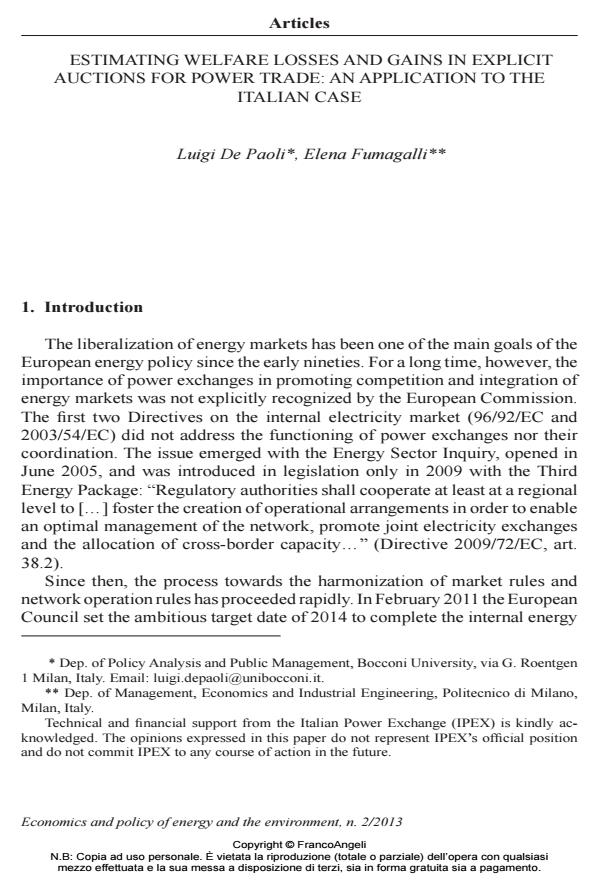Estimating welfare losses and gains in explicit auctions for power trade: an application to the Italian case
Titolo Rivista ECONOMICS AND POLICY OF ENERGY AND THE ENVIRONMENT
Autori/Curatori Luigi De Paoli, Elena Fumagalli
Anno di pubblicazione 2013 Fascicolo 2013/2 Lingua Inglese
Numero pagine 29 P. 153-181 Dimensione file 997 KB
DOI 10.3280/EFE2013-002009
Il DOI è il codice a barre della proprietà intellettuale: per saperne di più
clicca qui
Qui sotto puoi vedere in anteprima la prima pagina di questo articolo.
Se questo articolo ti interessa, lo puoi acquistare (e scaricare in formato pdf) seguendo le facili indicazioni per acquistare il download credit. Acquista Download Credits per scaricare questo Articolo in formato PDF

FrancoAngeli è membro della Publishers International Linking Association, Inc (PILA)associazione indipendente e non profit per facilitare (attraverso i servizi tecnologici implementati da CrossRef.org) l’accesso degli studiosi ai contenuti digitali nelle pubblicazioni professionali e scientifiche
Cross-border transmission capacities in Europe have been traditionally allocated via explicit auctions. As these will be replaced by implicit auctions, a relevant question regards the impact of this major transition on expected gains in social welfare. In this paper we study, first, the equations that describe the welfare loss associated with a suboptimal use of the transmission capacity. Second, by examining how suboptimal flows, and particularly adverse flows, change with the introduction of implicit auctions, we derive an original procedure that improves the accuracy of the welfare loss estimation when available market data are limited. Finally, we apply the proposed procedure to data pertaining to the Italian market and verify that for a net importer, such as Italy, the procedure derived in this work is particularly helpful in providing more accurate estimations of the welfare losses associated with explicit auctions. As implicit auctioning will eliminate these welfare losses, we interpret our results as a measure of the benefits associated with the current transition for the Italian market and use them to derive some more general implications.
Keywords:Electricity trade, Market coupling, social welfare.
Jel codes:Q43, L94, P48.
- ACER (2011). Framework Guidelines on Capacity Allocation and Congestion Management for Electricity. Available from: http://www.acer.europa.eu.
- Bohn R.E., Caramanis M.C., Schweppe F.C. (1983). Optimal pricing in electrical networks over space and time. The Rand Journal of Economics 15, 3: 360-376. DOI: 10.2307/2555444
- Commission de Régulation de l’Energie (2008). Rapport sur la gestion et l’utilisation des interconnexions électriques, Paris, Juin 2008.
- Creti A., Fumagalli E., Fumagalli E. (2010). Integration of electricity markets in Europe: relevant issues for Italy. Energy Policy 38, 11: 6966-6976. DOI: 10.1016/j.enpol.2010.07.013
- CWE (2010). Project Document: A report for the regulators of the Central West European (CWE) region on the final design of the market coupling solution in the region. Available from: http://www.tennet.eu.
- DG Competition (2007). Report on energy sector inquiry, SEC(2006) 1724, 10 January 2007. Available from: http://ec.europa.eu.
- EC (2002). Presidency Conclusions: Barcelona European Council 15-16 March 2002. Available from: http://ec.europa.eu.
- EC (2011). Conclusions on energy. European Council, 4 February 2011. Available from: http://www.consilium.europa.eu.
- EC (2012). Energy Markets in the European Union in 2011, 15 November 2012. Available from: http://ec.europa.eu.
- Gelmini A., Siface D., Benini M., Zani A. (2012). Valutazione dell‘impatto sul mercato elettrico italiano di un price coupling con i Paesi vicini. L’Energia Elettrica, luglio-agosto, 45-58.
- Ehrenmann A., Neuhoff K., (2009). A comparison of electricity market designs in networks. Operations Research, 57, 2: 274-286. DOI: 10.1287/opre.1080.0624
- ENTSO-E (2012). Network Code on Capacity Allocation and Congestion
- Management. Proposal, 27 September 2012. Available from: https://www.
- entsoe.eu.
- Gilbert R.J., Neuhoff K., Newbery D.M., (2004). Allocating transmission to mitigate market power in electricity networks. The RAND Journal of Economics, 35, 4: 691-709. DOI: 10.2307/1593768
- GME (2010). Relazione annuale 2009. Available from: www.mercatoelettrico.org.
- Hobbs B., Rijkers F., Boots M., (2005). The more cooperation, the more competition? A Cournot analysis of the benefits of electric market coupling. The Energy Journal, 26: 69-97. DOI: 10.5547/ISSN0195-6574-EJ-Vol26-No4-5
- Malaguzzi Valeri L., (2009). Welfare and competition effects of electricity
- interconnection between Ireland and Great Britain. Energy Policy, 37, 11: 4679-4688. DOI: 10.1016/j.enpol.2009.06.020
- Meeus L., (2011). Implicit auctioning on the Kontek Cable: Third time lucky? Energy Economics, 33, 3: 413-418. DOI: 10.1016/j.eneco.2010.10.008
- Oettinger G., (2012). An integrated electricity market by 2014: How to make this political goal a Reality? Speech, Brussels, 19 January 2012. Available from: http://ec.europa.eu.
- Pellini E., (2012). Measuring the impact of market coupling on the Italian electricity market. Energy policy, 48: 322-333. DOI: 10.1016/j.enpol.2012.05.029
- TERNA (2006-2011). Dati statistici. Available from: www.terna.it.
- Turvey R., (2006). Interconnector economics. Energy Policy, 34, 13: 1457-1472. DOI: 10.1016/j.enpol.2004.11.009
- Vassilopoulos P. (2013). Bourses et solidarité électrique en Europe. Economies et Sociétés, Série Economie de l’Energie, EN 12, 02: 319-345.
Luigi De Paoli, Elena Fumagalli, Estimating welfare losses and gains in explicit auctions for power trade: an application to the Italian case in "ECONOMICS AND POLICY OF ENERGY AND THE ENVIRONMENT" 2/2013, pp 153-181, DOI: 10.3280/EFE2013-002009